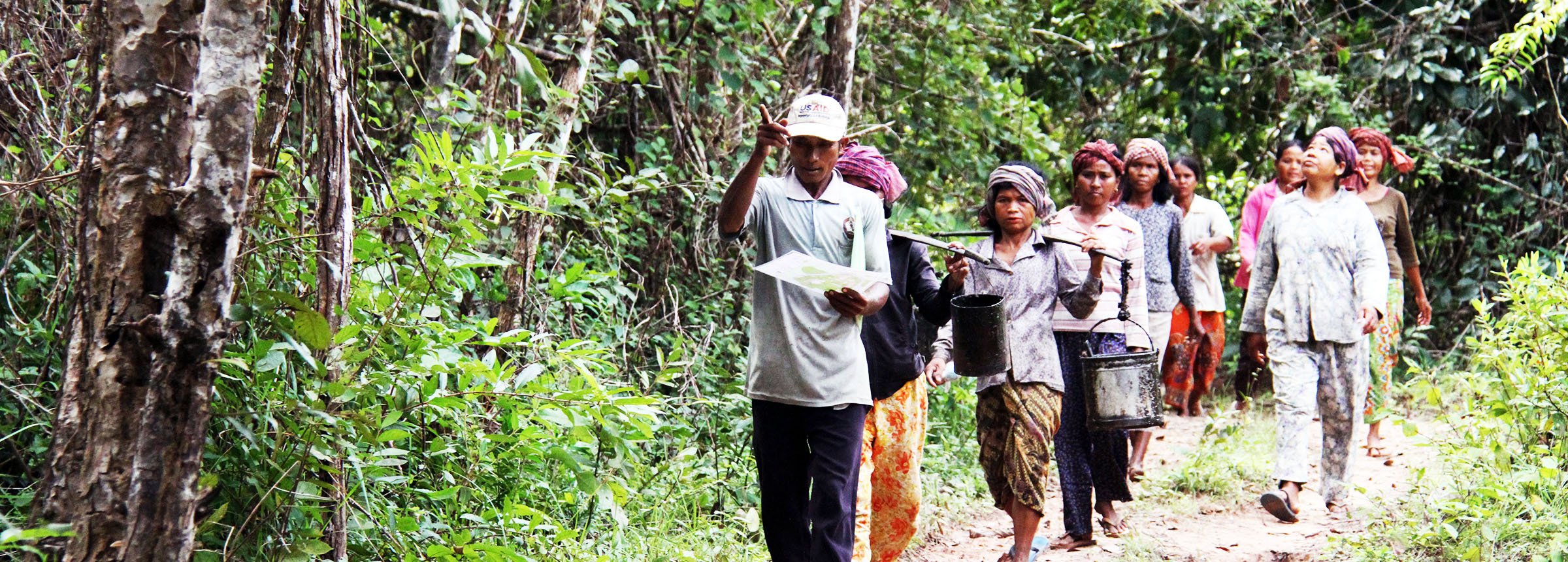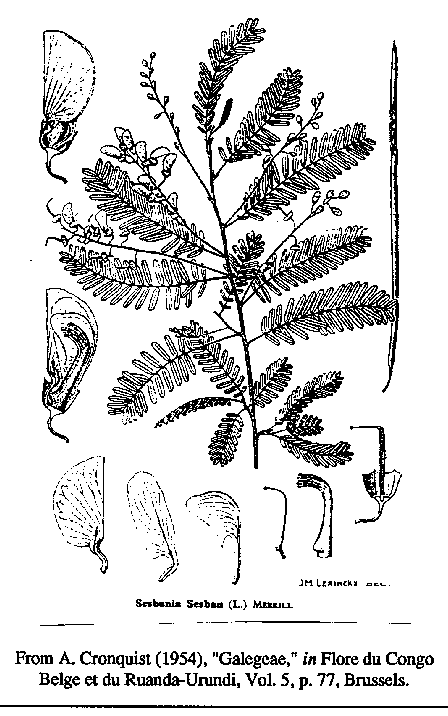
Sesbania grandiflora: NFT for beauty, food, fodder and soil improvement
June 1994 NFTA 94-05
A quick guide to useful nitrogen fixing trees from around the world
Sesbania grandiflora is a tree that grows rapidly, provides light shade, and is often grown as an ornamental. This soft-wooded tree’s leaves are used as fodder and its flowers as food. Grandiflora is planted in gardens for its intercropping compatibility and soil-improving properties.
 Botany
Botany
Sesbania grandiflora (L.) Poir. is a tree that grows to 8-10 m in height. The pink-red or white flowers of this papilionaceous (pea-like flowered) legume are unusually large (5-10 cm in length and about 3 cm wide before opening); this novelty may be the principal reason for grandiflora having been distributed by man throughout the tropics and subtropics. Within its genus, S. grandiflora is a member of the subgenus Agati, and it is thus more closely related to the unusual littoral sesbanias of Pacific islands than to the more typical sesbanias of subgenus Sesbania, such as the perennial S. sesban and the annual sesbanias grown for green manure (such as S. cannabina).
Grandiflora’s pinnate leaves may be 30 cm long, with 12-20 pairs of oblong, rounded leaflets averaging 3-4 cm long and about 1 cm wide. The leaves are borne at the terminals of branches, and the canopy is open, with a thin crown which produces light shade. Its racemes bear 2-3 flowers. The pods are usually 30-50 cm long by about 8 mm wide. The seeds are tan to red-brown, 6-8 x 3-5 mm, 14-20 weighing 1 g. The trunk may reach 25 cm diameter at breast height. Grandiflora may live 20 years or more.
Grandiflora is very closely related to the endemic Australian species, S. formosa. This relationship supports the supposition that grandiflora may have originated in Indonesia. S. formosa bears white flowers and is often indistinguishable from grandiflora to the casual observer. The two species appear to have similar growth habits and adaptivity, and it is possible that S. formosa also can be used for the purposes described here for grandiflora.
Distribution
Grandiflora is found in cultivation throughout the tropics and subtropics.
Ecology
Because wild populations of grandiflora are unknown, its natural habitat is uncertain. Grandiflora is grown most successfully in the lowland tropics (below 1000 m elevation) and warm, frost-free subtropics. It can be grown in regions with as little as 800 mm rainfall or as much as 2000-4000 mm. It seems to prefer a bimodal rainfall distribution, growing rapidly during wet seasons but capable of withstanding prolonged dry seasons of up to nine months. Grandiflora is tolerant of soil salinity and waterlogging, and withstands occasional short periods of flooding. It is well adapted to heavy clay soils.
Uses
Fodder, food, and soil improvement are the principal uses for grandiflora.
Fodder. Grandiflora is valued as a fodder in many regions. In south-central Lombok, Indonesia, grandiflora grown around rice paddy bunds provides up to 70 percent of the diets of cattle and goats during the annual eight-month dry season (Mudahan Hazdi, personal communication). The leaves contain as much as 25-30 percent crude protein.
Although ruminants readily consume grandiflora fodder, and its digestibility is high, some feeding studies have indicated that antinutritional factors are present. Until further research provides clear guidelines, caution should be used in feeding S. grandiflora to ruminants and other animals, and restricting feeding to less than 30 percent of dry matter intake is suggested. Grandiflora leaf is toxic to chickens and should not be fed to them or other monogastric animals.
Soil improvement. Grandiflora is often maintained in gardens and around crop fields for its contribution of nitrogen. The light shade cast by its canopy does not block much light, allowing the growth of companion plants. Falling leaflets and flowers recycle nutrients to the ground. Seedlings grow rapidly enough that they have been used similarly to annual green manure crops. For example, grown around paddy bunds for incorporation before planting the subsequent rice crop.
Wood. The wood is rather light and not ideal for firewood or pulping; the bark is thick and corky and is a further detriment to either of these uses. The trunks may be used as poles for temporary shelters and sheds, but they may not last very long due to rots and insect infestation.
Food. Leaves, seed pods, and flowers of grandiflora are prepared as food. The young, tender pods are cooked similarly to other green beans. In South Asia the young leaves are chopped and sautéed, perhaps with spices, onion, or coconut milk. In the Philippines, unopened white flowers are a common vegetable, steamed or cooked in soups and stews after the stamen and calyx have been removed. Selection of white-flowered varieties that flower profusely has resulted from this use in the Philippines.
Other uses. Grandiflora has been used to shade nurseries and some crops, such as turmeric, as support for climbing crops such as pepper and betel vine, and as an element of windbreaks. The leaves of the tree have various uses in the herbal medical lore of certain regions.
Culture and Management. Grandiflora is grown from seed, which may be planted without scarification. Stored seeds lose viability within a year or two. Seeds may be direct-sown or transplanted from nurseries; bare-rooted transplants are usually successful.
Seedling growth of grandiflora may be very rapid. Under harsh conditions or neglect, however, seedling survival may be poor. The leaf canopy is open and casts only light shade, hence its popularity in gardens.
Grandiflora cannot be coppiced or pollarded. Harvesting leaves for fodder must be done selectively, to avoid complete defoliation, and cannot be done more than a few times per year. More intensive harvesting, such as managing as a hedgerow, reduces the life of the tree. For example, cutting at 1 m high five times a year can result in tree mortality. Because grandiflora establishes so rapidly, frequent replanting is a management option if heavy harvesting results in tree decline.
Where flowers and pods are harvested for consumption as vegetables, the structure of the tree is shaped by pruning so that the canopy remains low, within reach for convenient harvesting.
Symbiosis
The rhizobia strains that nodulate sesbanias are somewhat specialized and may not be present where sesbanias have not been grown previously. Test plantings should be done to see if infective rhizobia are present in the soil, or if use of a rhizobia seed inoculant at planting will be necessary.
Limitations
Grandiflora’s soft wood is susceptible to damage by insects. Fodder cuttings cannot be severe. Seed recovery may be limited by pod pests. Seed viability declines after one year.
References
Evans, Dale O. 1990. What is Sesbania? Botany, taxonomy, plant geography ,and natural history of the perennial members of the genus. In: B. Macklin and D.O. Evans (eds), Perennial Sesbania species in agroforestry systems. Nitrogen Fixing Tree Association. p. 5-19.
Evans, D.O., and Macklin, B. (eds). 1990. Perennial Sesbania production and use. Nitrogen Fixing Tree Association. 41 p.
Evans, D.O., and Rotar, P.P. 1987. Sesbania in agriculture. Westview Press, Boulder, Colorado, U.S.A.
This issue was prepared by Dale O. Evans, Research Associate, Department of Horticulture, University of Hawaii, 3190 Maile Way, Honolulu, Hawaii 96822, USA.
A publication of the Forest, Farm, and Community Tree Network (FACT Net)
